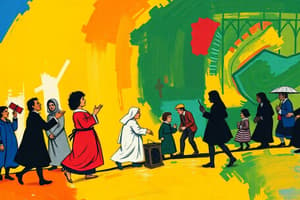Podcast
Questions and Answers
What does the Second Great Awakening include?
What does the Second Great Awakening include?
- Women's rights
- Temperance movement
- Education
- All of the above (correct)
What term did Charles Finney create to describe the revival-rich area in New York?
What term did Charles Finney create to describe the revival-rich area in New York?
Burned-Over District
Who was an influential revivalist preacher that coined the term 'Burned-Over District'?
Who was an influential revivalist preacher that coined the term 'Burned-Over District'?
Charles G. Finney
Who founded the Methodist movement?
Who founded the Methodist movement?
What religion teaches that man cannot get into Heaven by faith alone?
What religion teaches that man cannot get into Heaven by faith alone?
Who was the leader of the Temperance Movement?
Who was the leader of the Temperance Movement?
Who founded Mormonism and claimed to be a prophet?
Who founded Mormonism and claimed to be a prophet?
What group practiced celibacy and was part of the United Society of Believers in Christ's Second Coming?
What group practiced celibacy and was part of the United Society of Believers in Christ's Second Coming?
Who coined the term 'free love'?
Who coined the term 'free love'?
What group rejected key points of orthodox Protestant beliefs?
What group rejected key points of orthodox Protestant beliefs?
What did Transcendentalists believe about truth?
What did Transcendentalists believe about truth?
Who emphasized the individuality of the soul and the harmony between the soul and nature?
Who emphasized the individuality of the soul and the harmony between the soul and nature?
What literary work did Henry David Thoreau write that reflects his beliefs?
What literary work did Henry David Thoreau write that reflects his beliefs?
What was Brook Farm known for?
What was Brook Farm known for?
What did benevolent societies provide to urban residents?
What did benevolent societies provide to urban residents?
Who was a prominent abolitionist writer and escaped slave?
Who was a prominent abolitionist writer and escaped slave?
Who were notable members of the American Quakers who opposed slavery?
Who were notable members of the American Quakers who opposed slavery?
What did Lucretia Mott advocate for during the Seneca Falls Convention?
What did Lucretia Mott advocate for during the Seneca Falls Convention?
What abolitionist believed in immediate emancipation without delay?
What abolitionist believed in immediate emancipation without delay?
What was the purpose of the General Antislavery Convention in 1840?
What was the purpose of the General Antislavery Convention in 1840?
Flashcards are hidden until you start studying
Study Notes
Second Great Awakening
- Catalyst for various social reform movements, including women's rights, temperance, and education.
- Encouraged new religious communities and Utopian societies.
Burned-Over District
- Coined by Charles Finney, it refers to a region in New York that had undergone extensive revivals, implying spiritual exhaustion among its residents.
Charles G. Finney
- Influential revivalist preacher active from 1825-1835 in New York, emphasized emotional appeal in evangelism.
- Advocated "perfectionism," promoting the idea that redeemed Christians reflect God's perfection and should engage in reform movements.
Methodism
- Founded by John Wesley, this movement separated from the Anglican Church, emphasizing self-discipline and methodical religious practice.
Calvinism
- Originated in the early 1500s by John Calvin; teaches that faith alone cannot guarantee salvation, emphasizing predestination.
Lyman Beecher
- Presbyterian minister and leader of the Temperance Movement, he preached a less orthodox version of Calvinism from 1798-1832 across several northeastern states.
Joseph Smith
- Founder of Mormonism, claimed divine instruction led him to create a new church and wrote the Book of Mormon in the 1830s, advocating for polygamy.
Shakers
- Utopian community promoting celibacy, established in England around 1750, with settlements in New England and the Midwest.
John Humphrey Noyes
- Created the Oneida Community, a utopian socialist society promoting "free love" and complex marriage arrangements.
Unitarianism
- Rejected orthodox Christian beliefs, focused on individual reasoning and morality, with key figures like Ralph Emerson and Theodore Parker.
- Founded the Transcendental Club in 1836 in New York.
Transcendentalism
- No formal creed; centered on individual spiritual truth and moral action.
- Influenced by Romanticism, promoting ideas of individualism, nature, and communal living.
Ralph Waldo Emerson
- Major thinker of the Transcendental movement, promoted intellectual independence in his essays "The American Scholar" and "Self-Reliance."
Henry David Thoreau
- Advocated for simplicity and connection with nature; known for "Resistance to Civil Government," exploring civil disobedience.
Brook Farm
- Utopian community founded by George Ripley in the mid-1840s, embracing cooperative principles as an alternative to capitalism.
Benevolent Societies
- Aimed to reach urban populations with limited church access, led by middle-class women focusing on education and social reform, including temperance.
Frederick Douglass
- Prominent African American abolitionist and writer, escaped slavery and published "The North Star," advocating against slavery through his speeches and writings.
American Quakers
- Early abolitionists who, from the late 17th century, worked towards ending slavery, advocating for emancipation through moral persuasion.
Lucretia Mott
- Quaker, abolitionist, and women's rights advocate; key figure at the Seneca Falls Convention, co-authored the Declaration of Sentiments in 1848.
William Lloyd Garrison
- Leading abolitionist who advocated for immediate emancipation; helped found the American Antislavery Society in 1833.
General Antislavery Convention
- In 1840, over 500 abolitionists convened in England to address slavery, fostering cooperation between reformers in the U.S. and Britain, leading to the Seneca Falls Convention's inception.
Studying That Suits You
Use AI to generate personalized quizzes and flashcards to suit your learning preferences.




